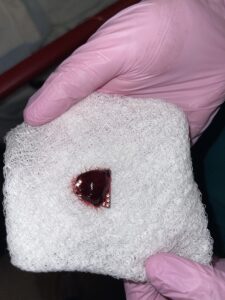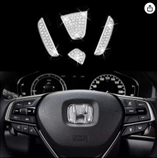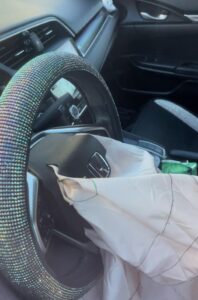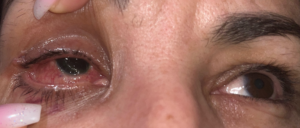PLG Files Product Liability Lawsuit Against Amazon for Loss of Woman’s Eye
A new product liability lawsuit has been filed by the personal injury attorneys at the Piccuta Law Group. The lawsuit alleges that Amazon is responsible for selling a dangerous product. Specifically, that Amazon’s sale of the dangerous product caused the loss of a woman’s eye. The lawsuit seeks damages against Amazon for pain, suffering, disability, emotional distress, medical expenses and loss of enjoyment of life.
The Product Liability Lawsuit Against Amazon
The product liability lawsuit was filed earlier this month in Santa Cruz County Superior Court. The case is entitled Cecilia Martinez v. Amazon.com Services, LLC. The lawsuit was assigned to Judge Timothy Schmal in Department 10 and designated case # 24CV00381.
The Claims in the Product Liability Lawsuit
The product liability lawsuit against Amazon sets forth six claims. The claims are as follows:
- Strict Product Liability – Design Defect
- Strict Product Liability – Manufacturing Defect
- Strict Product Liability – Failure to Warn
- Negligence – Product Liability
- Negligence – Failure to Warn
- Negligence – Failure to Recall
Each claim allows for the recovery of the client’s damages. In other words, the product liability lawyers at Piccuta Law Group only need to prevail on a single claim in order to recover damages and win the case for the client.

What is Strict Liability?
Strict liability is a standard of liability that holds a person or company responsible for injuries regardless of intent. It makes the person or company legally responsible for injuries and damages without the injured person having to prove fault.
How Strict Liability Applies to Product Liability in California
In a product liability lawsuit a person only needs to prove they bought a dangerous product from a seller to hold the seller responsible for resulting injuries. The theory is that the injuries caused by dangerous products should be borne by those who profit from selling the products to the consumer. This includes both retailers and manufacturers.
In other words, a company can be responsible for selling a dangerous product even though they were not the ones who designed or made it.
In other words, a company can be responsible for selling a dangerous product even though they were not the ones who designed or made it. In fact, any party in the vertical chain of distribution of consumer goods can be held responsible. Any company or person identifiable as an integral part of the overall producing and marketing of the product is subject to strict liability.
The Dangerous Product Sold by Amazon
The product liability lawsuit alleges that Amazon sold a car accessory that was dangerous. The car accessory was a steering wheel logo sticker. The decorative sticker was designed to attach to the voids around the car logo in the center of the steering wheel.
The decorative sticker was made of four metal pieces on which rhinestones were placed. These pieces were adhesive backed and designed so the owner of the vehicle could install them onto their steering wheel. A picture of the product is set forth below:

How the Client Found the Dangerous Product on Amazon
The client did an internet search for accessories for her newly acquired 2020 Honda Civic and was directed to the website www.amazon.com. She ultimately decided to purchase two products she saw on the website. Both products were described as “bling” car accessories. These products were adorned with decorative imitation diamonds/rhinestones.
The product was titled “AEEIX Car Interior Bling Trim Accessories Steering Wheel Logo Sign 3D Decals Rhinestone Cover for Honda Civic Accord City Fit CR-V XR-V UR-V Odyssey Crosstour Vezel 2013-2020.” Amazon’s website described the product as a “sparkly bling car steering wheel decorative diamond sticker fit for Honda, beautiful and stylish.” After receiving the product, the client installed the product around the Honda emblem of her steering wheel as intended, instructed and designed.
The Product Manufacturer
By all appearances, the product was not manufactured by Amazon. Instead, it was manufactured by a company in China. However, details about the company are difficult to ascertain.
The company does not appear to be established or have significant assets. The company appears to be a “fly by night” organization. This is true for many of the companies whose products regularly appear on Amazon’s website and are sold by it.
How Amazon Previously Avoided Responsibility for Selling Dangerous Products
Prior to 2020, Amazon was able to avoid responsibility for the dangerous products it sold in California by claiming it was not a retailer or seller. Amazon argued that it was merely a platform that connected sellers and buyers. As such, it was not a retail seller in the vertical chain of distribution of products to a consumer and could not be held liable.
Specifically, Amazon claimed it was merely an online marketplace where third-party products were offered for sale. It argued that it was simply a provider of services by maintaining an online marketplace, warehousing and shipping goods and processing payments. Amazon was successful in convincing the courts that it was not a seller of products.
Two Cases Held That Amazon Could be a Seller Subject to Strict Product Liability
For years, Amazon successfully convinced courts that it was merely a platform for introducing sellers to buyers and facilitating those sales. In sum, Amazon took the approach that it was no different than Ebay or Etsy. However, in 2020 and 2021 two California appellate court decisions held otherwise.
The First Product Liability Lawsuit Holding that Amazon Could be a Seller
In Bolger v. Amazon.com, LLC, a California appellate court overturned a lower court who had held that Amazon was not a seller of goods that could be responsible for strict product liability. The case involved the sale of a laptop battery that exploded and caused a buyer to suffer severe burns. The appellate court focused on the interaction that Amazon had with the consumer and the control Amazon had with respect to selling and delivering the product.
The court noted that Amazon created the website and enticed the consumer to purchase from its website. It set forth that the sale listing had to conform to Amazon’s rules. It recognized that upon purchase of the product, it was added to Amazon’s cart, retrieved by Amazon personnel and shipped in Amazon branded packaging. It further noted that any returns would need to go through Amazon and that the consumer would have no interaction with the manufacturer of the product. Based upon this analysis, the court concluded that Amazon could be a seller subject to strict product liability.
The Second Product Liability Lawsuit Holding that Amazon Could be a Seller
In Loomis v. Amazon.com, LLC, a second California appellate court held that Amazon could be responsible in strict product liability as a seller of goods. The case involved the sale of a defective hoverboard. The hoverboard caught fire while charging at night causing the owner to suffer burns and damages.
Like the first case, Loomis analyzed Amazon’s role in the sale and distribution of the hoverboard. The court concluded that Amazon was in the vertical chain of delivering the product to the consumer. The court stated:
“As technology advances, innovation is paving the way to new business practices. Amazon is on the leading edge of e-commerce. Based on our review…we are persuaded that Amazon’s own business practices make it a direct link in the vertical chain of distribution under California’s strict liability doctrine.”
we are persuaded that Amazon’s own business practices make it a direct link in the vertical chain of distribution under California’s strict liability doctrine.
Since these cases came out, other California courts have followed and issued similar decisions.
Why Amazon is Responsible to Our Client for the Dangerous Product It Sold
Amazon used search engine optimization to direct the client to its website where the product was introduced and presented to her. The client then bought the product from Amazon through its website. Amazon took the client’s order and payment.
Amazon then facilitated the transmission of the product to the client and received compensation from the sale. The client received order confirmations and shipping information directly from Amazon. The client was directed to communicate any questions regarding the product or transaction to Amazon. Plaintiff’s purchase was subject to Amazon’s rules and policies of sale. Any return of the product would have been through Amazon. As a result, Amazon is in the vertical chain of delivering the product to the client and may be held strictly liable for her resulting injuries.
How the Dangerous Product Caused the Client’s Injury
On October 15, 2023, the client was driving her 2020 Honda Civic when she was involved in a minor impact car accident. Specifically, the front of her car came into contact with another vehicle. As a result of the impact, the front driver side airbag of her car deployed.

The deployment of her driver side air bag caused all of the adhesive backed product pieces to dislodge from her steering wheel. The pieces were projected throughout the cabin of the vehicle like shrapnel from a grenade. One of the pieces went directly into Plaintiff’s right eye.
The Injury the Client Sustained from the Dangerous Product
The client’s eye was completely destroyed by the projectile. The client suffered a completely flattened globe with a large laceration from medial to lateral equator. She is completely blind in her right eye. She has no light perception.
A procedure to remove her damaged eye is scheduled for the future. She will then have the option of wearing a patch to cover the void or inserting a prosthetic eye instead. The loss of the client’s eye has caused her extreme pain and suffering.

The emotional aspects of dealing with her lost eye have proven especially difficult. The client is a single woman. She is now self-conscious about dating and being in social settings. The loss of her eye has required her to seek out counseling and other mental health treatment to cope with her injuries.
NHTSA Issued an Alert About the Dangerous Product
On November 6, 2023, the National Highway Traffic Safety Administration issued a consumer alert entitled “Don’t Buy or use Steering Wheel Decorative Emblem Decals.”
The consumer alert stated:
“The National Highway Traffic Safety Administration warns consumers about aftermarket steering wheel decals that could potentially cause significant injury or death. At least one driver suffered a serious injury that resulted in the loss of sight in one eye, when an aftermarket emblem adorned with rhinestones became dislodged from the steering wheel in a crash and hit the driver in the face.
The product is a metal or plastic plate, usually covered with rhinestones or shiny decorations, with an adhesive back that cover the vehicle’s logo in the center of the steering wheel. In a crash, the force of a deploying air bag can turn the product into a projectile, resulting in serious injury or death.
Unlike the permanently affixed logo on your vehicle’s steering wheel, these aftermarket decals can easily become dislodged when the air bag is deployed. Any alterations or changes to your air bag or its cover can also cause it to not function correctly.
NHTSA is asking consumers to avoid purchasing these steering wheel decals for all vehicle makes and models. Consumers should also remove any such decals that they have already applied to their steering wheels.”
Amazon Continues to Sell the Dangerous Products
Amazon still sells these dangerous products on its website. This is despite both the consumer alert by NHTSA and the product liability lawsuit filed by our office for the client. Amazon simply does not care about the safety of consumers. The fact that it continues to sell a product that can severely injure and kill individuals, when used as designed, is proof of that. Our injury lawyers will seek to hold Amazon fully responsible for its reckless conduct.
Contact an Experienced Injury Lawyer Today
If you or a loved one was harmed or injured due to the acts of another party, contact our law office today to discuss your case. A consultation is free and costs you nothing. We only earn a fee if we recover for you. An experienced lawyer is available now.
About the author: The content on this page was written by California personal injury attorney and civil rights lawyer Charles “Tony” Piccuta. Piccuta graduated with honors from Indiana University-Maurer School of Law in Bloomington, Indiana (Previously ranked Top 35 US News & World Report). Piccuta took and passed the State bars of Arizona, California, Illinois and Nevada (all on the first try). He actively practices throughout California and Arizona. He is a winning trial attorney that regularly handles serious personal injury cases and civil rights lawsuits. He has obtained six and seven figure verdicts in both state and federal court. He has been recognized by Super Lawyers for six years straight. He is AV Rated by Martindale Hubble. He is a member of the Consumer Attorneys of California, American Association for Justice, National Police Accountability Project, Arizona Association of Justice, and many local county and City bar associations.
Disclaimer: The information on this web site is attorney advertising and is for informational purposes only. It does not constitute legal advice. Reading and relying upon the content on this page does not create an attorney-client relationship. If you are seeking legal advice, you should contact our law firm for a free consultation and to discuss your specific case and issues.
References:

